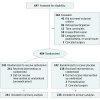Effect of Albuterol Premedication vs Placebo on the Occurrence of Respiratory Adverse Events in Children Undergoing Tonsillectomies: The REACT Randomized Clinical Trial
- PMID: 31009034
- PMCID: PMC6547220
- DOI: 10.1001/jamapediatrics.2019.0788
Effect of Albuterol Premedication vs Placebo on the Occurrence of Respiratory Adverse Events in Children Undergoing Tonsillectomies: The REACT Randomized Clinical Trial
Abstract
Importance: Tonsillectomy is a common pediatric procedure for the treatment of sleep-disordered breathing and chronic tonsillitis. Up to half of children having this procedure experience a perioperative respiratory adverse event.
Objective: To determine whether inhaled albuterol sulfate (salbutamol sulfate) premedication decreases the risk of perioperative respiratory adverse events in children undergoing anesthesia for tonsillectomy.
Design, setting, and participants: A randomized, triple-blind, placebo-controlled trial (the Reducing Anesthetic Complications in Children Undergoing Tonsillectomies [REACT] trial) was conducted at Perth Children's Hospital (formerly Princess Margaret Hospital for Children), the only tertiary pediatric hospital in Western Australia. Participants included 484 children aged 0 to 8 years who were undergoing anesthesia for tonsillectomy. The study was conducted between July 15, 2014, and May 18, 2017.
Interventions: Participants were randomized to receive either albuterol (2 actuations, 200 μg) or placebo before their surgery.
Main outcomes and measures: Occurrence of perioperative respiratory adverse events (bronchospasm, laryngospasm, airway obstruction, desaturation, coughing, and stridor) until discharge from the postanesthesia care unit.
Results: Of 484 randomized children (median [range] age, 5.6 [1.6-8.9] years; 285 [58.9%] boys), 479 data sets were available for intention-to-treat analysis. Perioperative respiratory adverse events occurred in 67 of 241 children (27.8%) receiving albuterol and 114 of 238 children (47.9%) receiving placebo. After adjusting for age, type of airway device, and severity of obstructive sleep apnea in a binary logistic regression model, the likelihood of perioperative respiratory adverse events remained significantly higher in the placebo group compared with the albuterol group (odds ratio, 2.8; 95% CI, 1.9-4.2; P < .001). Significant differences were seen in children receiving placebo vs albuterol in laryngospasm (28 [11.8%] vs 12 [5.0%]; P = .009), coughing (79 [33.2%] vs 27 [11.2%]; P < .001), and oxygen desaturation (54 [22.7%] vs 36 [14.9%]; P = .03).
Conclusions and relevance: Albuterol premedication administered before tonsillectomy under general anesthesia in young children resulted in a clinically significant reduction in rates of perioperative respiratory adverse events compared with the rates in children who received placebo. Premedication with albuterol should be considered for children undergoing tonsillectomy.
Trial registration: Australian New Zealand Clinical Trials Registry identifier: ACTRN12614000739617.
Conflict of interest statement
Figures

Comment in
-
Salbutamol administered preoperatively to children undergoing tonsillectomy resulted in a significant reduction in rates of respiratory adverse events.Arch Dis Child Educ Pract Ed. 2020 Dec;105(6):383-384. doi: 10.1136/archdischild-2019-318590. Epub 2020 Jan 22. Arch Dis Child Educ Pract Ed. 2020. PMID: 31969376 No abstract available.
Similar articles
-
Effect of Intranasal Dexmedetomidine or Midazolam for Premedication on the Occurrence of Respiratory Adverse Events in Children Undergoing Tonsillectomy and Adenoidectomy: A Randomized Clinical Trial.JAMA Netw Open. 2022 Aug 1;5(8):e2225473. doi: 10.1001/jamanetworkopen.2022.25473. JAMA Netw Open. 2022. PMID: 35943745 Free PMC article. Clinical Trial.
-
Premedication with salbutamol prior to surgery does not decrease the risk of perioperative respiratory adverse events in school-aged children.Br J Anaesth. 2017 Jul 1;119(1):150-157. doi: 10.1093/bja/aex139. Br J Anaesth. 2017. PMID: 28974069 Clinical Trial.
-
Effect of Tulobuterol Patch Versus Placebo on the Occurrence of Respiratory Adverse Events in Children Undergoing Tonsillectomies: A Randomized Controlled Trial.Anesth Analg. 2023 Jun 1;136(6):1067-1074. doi: 10.1213/ANE.0000000000006355. Epub 2023 May 19. Anesth Analg. 2023. PMID: 36727868 Clinical Trial.
-
Clinical Practice Guideline: Tonsillectomy in Children (Update)-Executive Summary.Otolaryngol Head Neck Surg. 2019 Feb;160(2):187-205. doi: 10.1177/0194599818807917. Otolaryngol Head Neck Surg. 2019. PMID: 30921525 Review.
-
Future of pediatric tonsillectomy and perioperative outcomes.Int J Pediatr Otorhinolaryngol. 2013 Feb;77(2):194-9. doi: 10.1016/j.ijporl.2012.10.016. Epub 2012 Nov 16. Int J Pediatr Otorhinolaryngol. 2013. PMID: 23159321 Review.
Cited by
-
The Effect of Albuterol Spray on Hypoxia and Bronchospasm in Patients with Chronic Obstructive Pulmonary Disease (COPD) under General Anesthesia: A bouble-Blind Randomized Clinical Trial.Ethiop J Health Sci. 2023 May;33(3):491-498. doi: 10.4314/ejhs.v33i3.12. Ethiop J Health Sci. 2023. PMID: 37576161 Free PMC article. Clinical Trial.
-
Recognizing Risks and Optimizing Perioperative Care to Reduce Respiratory Complications in the Pediatric Patient.J Clin Med. 2020 Jun 22;9(6):1942. doi: 10.3390/jcm9061942. J Clin Med. 2020. PMID: 32580323 Free PMC article. Review.
-
Development and Validation of a Risk Nomogram Model for Perioperative Respiratory Adverse Events in Children Undergoing Airway Surgery: An Observational Prospective Cohort Study.Risk Manag Healthc Policy. 2022 Jan 6;15:1-12. doi: 10.2147/RMHP.S347401. eCollection 2022. Risk Manag Healthc Policy. 2022. PMID: 35023976 Free PMC article.
-
Effect of Intranasal Dexmedetomidine or Midazolam for Premedication on the Occurrence of Respiratory Adverse Events in Children Undergoing Tonsillectomy and Adenoidectomy: A Randomized Clinical Trial.JAMA Netw Open. 2022 Aug 1;5(8):e2225473. doi: 10.1001/jamanetworkopen.2022.25473. JAMA Netw Open. 2022. PMID: 35943745 Free PMC article. Clinical Trial.
-
Sleep-Disordered Breathing and Cardiovascular Disease in Children and Adolescents: A Scientific Statement From the American Heart Association.J Am Heart Assoc. 2021 Sep 21;10(18):e022427. doi: 10.1161/JAHA.121.022427. Epub 2021 Aug 18. J Am Heart Assoc. 2021. PMID: 34404224 Free PMC article.
References
-
- ENTUK Indications for Tonsillectomy: Position Paper. London, UK: Royal College of Surgeons of England; 2009.
-
- Scottish Intercollegiate Guidelines Network Management of sore throat and indications for tonsillectomy. Edinburgh, UK: Scottish Intercollegiate Guidelines Network; 2010.
-
- von Ungern-Sternberg BS, Davies K, Hegarty M, Erb TO, Habre W. The effect of deep vs. awake extubation on respiratory complications in high-risk children undergoing adenotonsillectomy: a randomised controlled trial. Eur J Anaesthesiol. 2013;30(9):529-536. doi:10.1097/EJA.0b013e32835df608 - DOI - PubMed

